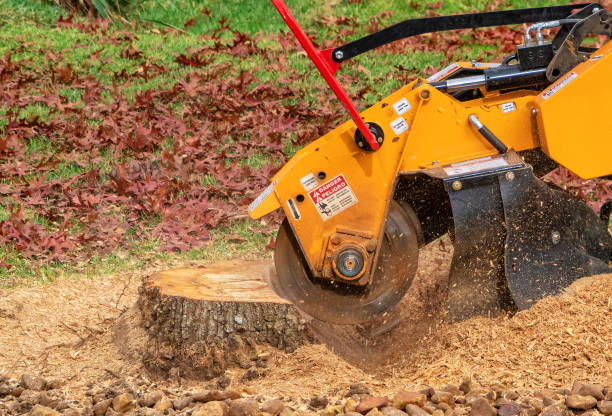When a tree comes down, the job isn’t really finished until the stump is gone. A leftover stump creates tripping hazards, attracts pests, and keeps roots alive longer than most property owners expect. Many people search for how to destroy tree stumps, yet the process requires far more than simply cutting close to the ground and walking away. ArborWorks handles stump removal often, and the right approach makes the job far safer and much more reliable.
Below is a clear explanation of the different approaches, what actually works, and why a professional service helps protect your yard, plumbing, soil, and structures.

How to Destroy Tree Stumps: Understanding Why Stumps Stay Alive
Some homeowners feel surprised when sprouts pop up around a stump months after the tree came down. Even without branches, the underground root system can keep pushing new growth. Anyone looking into how to kill a stump needs to understand this first.
A stump stays active because:
- Roots still store energy. Even with no canopy, the root system holds enough stored energy to fuel fresh shoots for several seasons. This means simple cutting will not stop the stump from trying to regrow.
- Moist soil feeds remaining root tissue. Damp soil allows roots to stay alive longer. Loose, rich soil encourages more sprouting, which means the stump continues to compete for water and nutrients.
- Decay takes years without help. Natural rot is slow. A large hardwood stump can stay in place for five to ten years. During that time, it can attract termites, carpenter ants, and fungal growth.
Because of this, a planned removal strategy is important. Homeowners who search how do I remove a tree stump usually come across several options, but the safest path depends on the size, species, and location of the stump.
How to Destroy Tree Stumps Using Physical Removal
Physical removal is the most reliable method. ArborWorks does this often for customers who want a clean, level area for grass, landscaping, or new construction.
Grinding the Stump
Stump grinding is the most common service. It’s fast and leaves the yard ready for fresh soil.
Grinding works well because:
- Grinding removes stump and surface roots. The grinder cuts the wood into mulch, reaching far enough below ground to stop future growth. This prevents fresh shoots from returning and keeps the area smooth for landscaping.
- The process avoids large holes. Grinding doesn’t pull up entire root systems, so the ground settles evenly instead of sinking.
- It works on nearly any size stump. Small to very large stumps all grind down well, which makes this option flexible for most yards.
As a trusted Tree Service in Covington, ArborWorks uses industry-safe grinders with guarding systems, proper PPE, and ISA-trained operators. This prevents property damage while making the process quick and predictable.
Digging Out the Stump
This method is best for smaller stumps or stumps with shallow root systems.
Digging works because:
- The entire stump and root flare can be removed. This prevents any future suckering and leaves the area clean for planting.
- It works great for replanting in the same exact spot. Many families want another tree in that location. Removing the full stump clears the space for healthy root growth.
For large stumps, digging becomes difficult, which is why grinding is usually recommended instead.
How to Destroy Tree Stumps with Natural Decay Acceleration
Some homeowners want a slower option that avoids heavy equipment. While this approach takes patience, it does help speed up natural breakdown.
Drilling and Adding Nitrogen
This method encourages faster decomposition.
It works like this:
- Drilled holes let air and moisture in. Increased airflow supports the fungi and microbes that break wood apart.
- Nitrogen helps microbes thrive. A high-nitrogen material helps soften the stump over time. The USDA notes that nitrogen encourages wood-decaying organisms, which helps the stump rot quicker.
- Over months, the stump weakens. This doesn’t destroy the stump instantly, but the wood becomes soft enough to break apart or grind more easily later.
This method works well only if safety is followed. Adding flammable materials, burning, or using household chemicals creates risks that ArborWorks strongly discourages.
How to Destroy Tree Stumps by Preventing Regrowth
Some property owners want to stop root sprouts first before complete removal. Here’s how that process works safely.
Cutting New Shoots Regularly
Cutting sprouts may sound simple, but it’s effective because:
- Sprouts lose the stump’s stored energy. Every cut forces the root system to use more energy to regrow. Repeated cutting eventually weakens the stump enough for permanent decline.
- Sprouting slows down over time. While it takes consistent attention, the stump loses strength after each cut.
- This works best when combined with removal later. Many customers use this as a temporary step until ArborWorks comes in with grinding equipment.
How to Destroy Tree Stumps Safely Without Harming Your Yard
Every stump has different structure and moisture levels. Safety matters because stumps sit near utilities, irrigation systems, and building foundations. ArborWorks always evaluates the site before choosing a method.
Here are the main safety points our team checks:
• Underground lines
Buried plumbing, electrical lines, and gas lines can sit close to roots. Grinding or digging without locating utilities is dangerous. ArborWorks locates utilities before any stump work starts.
• Soil stability
Some yards sit on soft or shifting soil. Heavy equipment needs stable ground. Our team checks for soggy ground, slopes, or erosion so the work stays safe.
• Root strength
Some species hold strong lateral roots that reach several feet out. This affects how deep and far the grinder must reach.
• Storm risk
Weak root systems left in place after partial removal can create issues later during storms. ArborWorks has a full Storm Prep & Risk Mitigation service if you want a complete evaluation.
These steps help protect both your home and the surrounding landscape.
How to Destroy Tree Stumps: Why Hiring ArborWorks Matters

Trying to figure out how to destroy tree stumps on your own often leads to extra work, unexpected hazards, and uneven results. ArborWorks provides ISA-certified guidance to protect your property long-term.
Here’s why so many local homeowners choose ArborWorks:
- Industry-safe tools and training. Stump grinders can throw debris, strike buried lines, or damage nearby structures. ArborWorks handles this daily with trained operators and controlled work zones.
- Full property care available. If the stump came from a storm or disease, we offer Tree Health Inspection, Tree Removal, Tree Trimming, and storm-readiness services.
- Faster results. Grinding eliminates the stump in a single visit instead of waiting months or years for natural decay.
- Cleaner finish. The area is leveled, mulched, and ready for planting or grass.
- No guesswork. ArborWorks provides clear next steps for soil health and long-term tree planning in your yard.
Contact ArborWorks for Tree Stump Removal in Louisiana
Learning how to destroy tree stumps gives property owners a better idea of what’s safe, what actually works, and why professional work delivers better results. ArborWorks helps with everything from sprout control to full grinding, and our ISA-certified team protects your home, soil, and surrounding trees during the process.
If you want a clean, hazard-free yard without the stress or risks, ArborWorks is ready to help.
Call ArborWorks at (985) 951-0128 or request service through our Contact Page.
Our team will evaluate your stump, explain the best removal plan, and help restore your landscape safely and efficiently.
FAQs About How to Destroy Tree Stumps
What’s the fastest way to destroy a tree stump?
Stump grinding is the fastest and safest method. It removes the stump below ground level and prevents future growth.
Can I pour chemicals on a stump to kill it?
Many store-bought chemicals can damage soil or nearby trees. ArborWorks recommends avoiding harsh chemicals and relying on safe removal or controlled decay methods.
How long does natural stump decay take?
A small stump may break down within a few years. Large hardwood stumps can last five to ten years without grinding.
Should I burn a stump?
Burning is risky, unpredictable, and illegal in some areas. It often fails to reach deep roots and can cause underground fires. ArborWorks does not recommend or offer this method.
Will grinding remove roots too?
Grinding removes the main stump and the upper root system. Deep roots will naturally decay over time.


